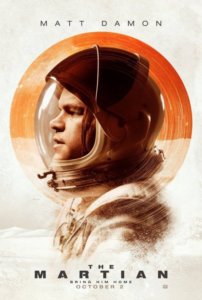Posts Tagged ‘survivor tale’
THE MARTIAN, Book Review

The Martian
Review of the Novel
By Andy Weir
THE MARTIAN became a must-read science fiction novel a few years ago. Not only did the book go mainstream, but the story captured the imagination of Twentieth Century Fox. Under Fox Entertainment, Drew Goddard adapted the book to screen and Ridley Scott was hired to direct. In 2015, THE MARTIAN became Scott’s top grossing film. Mark Watney, the hero of the story, became a household name as did many of his quips, like:
- In the face of overwhelming odds, I’m left with only one option: I’m gonna have to science the shit out of this.
- I don’t want to come off as arrogant here, but I’m the greatest botanist on this planet.
- They say once you grow crops somewhere, you have officially colonized it. So, technically, I colonized Mars. In your face, Neil Armstrong!
THE MARTIAN in novel form
THE MARTIAN tells the story of an astronaut stranded on Mars. He is a member of NASA’s third mission to the red planet, having traveled on Hermes, a one-of-a-kind craft that has the capability to reach Mars. The story is set in the year 2035. While the crew is on day 5 of their 30-day mission and living in a tent-like research structure, a 175 mph sandstorm erupts on Mars. This leads them to abort the mission, but while Watney and the rest of the crew rush out of the tent and are on their way to the ship that will take them back to the Hermes, Watney’s suit is penetrated by a blowing antenna. All of his fellow crew members know this to be a death sentence in the harsh Martian environment and in the confusion of the storm, they lose contact with him and make the tough decision to leave his body behind, assuming he is dead. But, Watney survives.
The rest of the story unfolds as part survivor tale, part rescue mission. The tension is palpable throughout. Watney is the main narrator, making journal entries about every challenge and every Mars-life-hack he performs to survive. He is an engineer and a botanist, so his skill-set comes in handy. He needs to make water, grow food and figure out a way to contact NASA to let them know he is alive. He meticulously details the science in his journal entries and they are funny, while being brilliant. When he does finally reach NASA and his former ship mates, the rescue mission begins, but not without its own challenges/impossibilities.
The narrative broadens in vital ways when NASA is contacted. Now, the reader sees new characters and just in time. It might not have been so compelling a read without the new voices and the new motivations. Watney’s story continues to be mainly told in his journal entries. The NASA folks come into the story via omniscient narrator. Very quickly, NASA tells Watney’s crew (still en route back to Earth) that Watney is alive. Now they become a part of the story, trying to figure out a way (if there is one) to rescue their fellow crewman…These characters are all interesting and are making decisions that ramp up the tension. Saving Watney is going to be extremely costly and potentially fatal for the Hermes and its crew. There are a million reasons to let Mark Watney die.
This story succeeds in capturing the unique voice of a space hero. Mark Watney cannot fly around like Ironman (a reality he bemoans at one point in the story), but his superpower is his ingenuity, his intelligence and his sense of humor in the face of the slimmest of odds. He is matched by NASA’s creative problem solving and his crew mates, who show themselves to be people of courage and sacrifice.
I laughed aloud reading this book (actually consumed it via audio book with my family while on a road trip…all four of us love a good scifi story and Weir’s first person narration does make for a great audio experience). Watney’s voice rings in one’s brain following a good listen.
I highly recommend this novel and will write another post for educators, as the science-inspired story potentially gets kids revved up about their studies.
To buy the Martian, click here.
